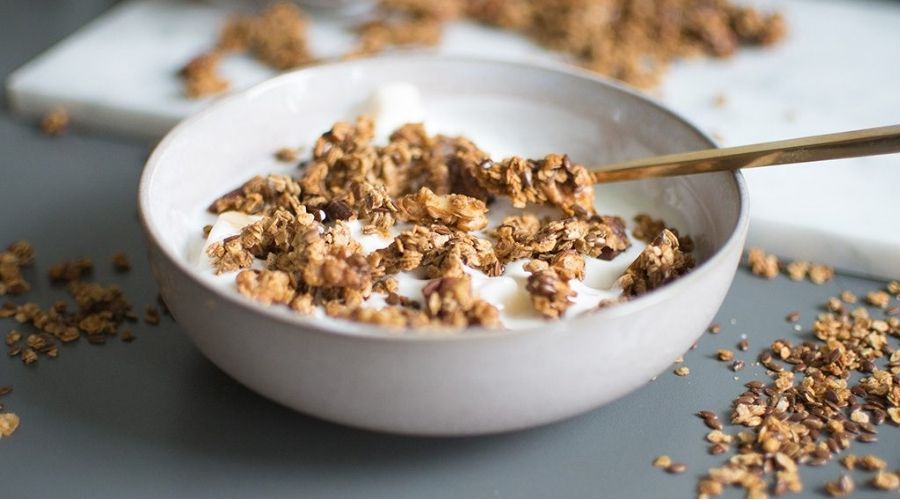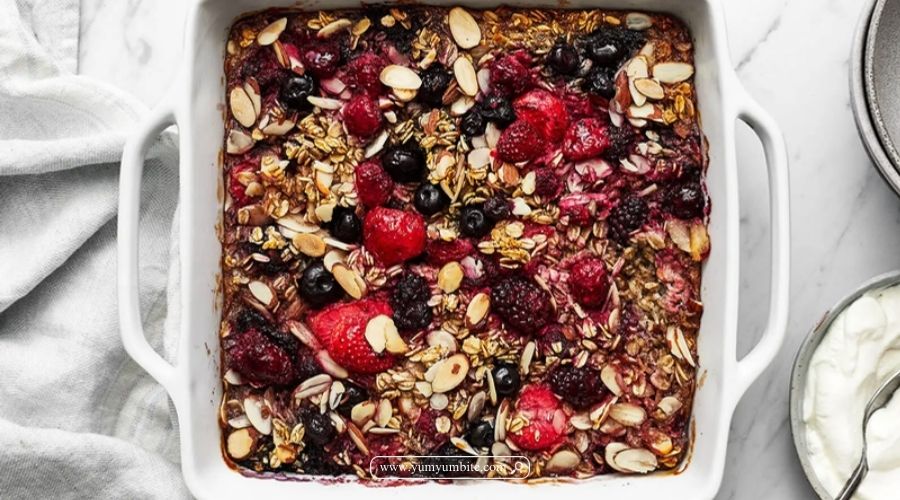Leftover baked oatmeal can be a delightful treasure in your kitchen, offering not only convenience but also a canvas for creativity.
Whether you whipped up a large batch for breakfast or have some remnants from a family brunch, finding new ways to enjoy this hearty dish can elevate your meals throughout the week.
From sweet treats like oatmeal muffins and pancakes to savory options that include vegetables and cheese, the possibilities are endless.
In this article, we’ll explore various delicious ideas for transforming leftover baked oatmeal into exciting new dishes that will keep your taste buds happy and your meal prep effortless.
What to Do with Leftover Baked Oatmeal: Creative Recipes and Tips
Embracing leftover baked oatmeal means you can reduce food waste while enjoying a variety of delicious meals.
With just a little creativity, this nutritious dish can be repurposed into numerous forms—from energy bites and muffins to savory bakes and smoothies.
Understanding how to effectively store and utilize your leftovers ensures that you can make the most out of your cooking efforts.
So the next time you have leftover baked oatmeal, don’t let it go to waste. Instead, try one of these innovative ideas and discover how versatile and delightful this humble dish can be.
With just a bit of imagination, your leftovers can become the highlight of your culinary adventures!
Make Oatmeal Muffins

Transforming leftover baked oatmeal into muffins is a delightful way to enjoy this nutritious dish in a portable format.
This option is appealing because it not only provides a convenient breakfast or snack but also allows for customization with your favorite mix-ins, such as nuts, fruits, or chocolate chips.
To prepare, simply blend the leftover oatmeal with eggs, a splash of milk, and any desired add-ins, then pour the mixture into a muffin tin and bake until golden.
Caution should be taken not to overmix, as this can lead to dense muffins.
These oatmeal muffins are perfect for meal prep and can be stored in the fridge or freezer for easy grab-and-go options.
Create Oatmeal Pancakes
Using leftover baked oatmeal to make pancakes is a fun and creative way to change up your breakfast routine.
This option is appealing because it combines the hearty texture of baked oatmeal with the fluffiness of pancakes, resulting in a delicious and satisfying meal.
To prepare, blend the leftover oatmeal with eggs, baking powder, and a little milk until you reach a pancake batter consistency. Cook the pancakes on a griddle or skillet until golden brown on both sides.
Caution is important to ensure the heat is not too high, as it can cause the pancakes to burn before they cook through.
Serve with syrup, yogurt, or fresh fruit for a wholesome breakfast.
Prepare Oatmeal Energy Bites
Leftover baked oatmeal can be transformed into energy bites, making for a nutritious snack that’s perfect for on-the-go.
This option is appealing because it combines the wholesome ingredients of oatmeal with nut butter, honey, and other add-ins like seeds or dried fruit, creating a healthy, energy-boosting treat.
To prepare, mix the leftover oatmeal with nut butter and sweetener, then form small balls and refrigerate until firm.
Caution should be exercised to avoid adding too much liquid, which can make the mixture too sticky.
These energy bites are not only delicious but also versatile, as you can easily tailor them to your taste preferences.
Make Oatmeal Bars
Transforming leftover baked oatmeal into bars is a fantastic way to create a nutritious and satisfying snack or breakfast option.
This choice is appealing because it allows for easy portion control and is perfect for meal prep.
To prepare, mix the leftover oatmeal with additional ingredients like nut butter, honey, and any desired toppings (such as nuts or dried fruit). Press the mixture into a lined baking dish and refrigerate until firm.
Caution is necessary to ensure the bars are not too thin, as they may crumble when cut.
These oatmeal bars can be individually wrapped for easy snacking throughout the week and are a healthy alternative to store-bought granola bars.
Create a Savory Oatmeal Bake

Leftover baked oatmeal can be transformed into a savory dish, offering a delightful twist on traditional breakfast flavors.
This option is appealing because it allows you to incorporate ingredients like cheese, vegetables, and herbs, making it a hearty and satisfying meal.
To prepare, mix the leftover oatmeal with beaten eggs, grated cheese, and your choice of sautéed vegetables, such as spinach or bell peppers. Pour the mixture into a greased baking dish and bake until set and golden on top.
Caution is necessary to avoid overbaking, which can lead to a dry texture.
This savory oatmeal bake can be served as a filling breakfast or a side dish for lunch or dinner.
Make Oatmeal Parfaits
Using leftover baked oatmeal to create parfaits is a fun and visually appealing way to enjoy this dish.
This option is appealing because it allows for layering flavors and textures, combining the creamy oatmeal with yogurt and fresh fruit for a delicious treat.
To prepare, layer the leftover oatmeal with your choice of yogurt and a variety of fruits like berries or bananas in a glass or bowl.
Caution should be taken to not pack the layers too tightly, as this can create a mushy texture.
These parfaits make for a nutritious breakfast or dessert and can easily be customized based on seasonal fruits or your favorite yogurt flavors.
Prepare Oatmeal Cookies
Transforming leftover baked oatmeal into cookies is a creative and tasty way to repurpose this dish.
This option is appealing because it combines the wholesome ingredients of oatmeal with the sweetness of cookies, making for a guilt-free treat.
To prepare, mix the leftover oatmeal with flour, eggs, sugar, and any desired add-ins like chocolate chips or nuts.
Scoop the dough onto a baking sheet and bake until golden brown.
Caution is important to ensure the cookies don’t spread too much, which can happen if the dough is too warm.
These oatmeal cookies are not only delicious but also versatile, as you can experiment with various flavors and textures.
Create a Smoothie Bowl
Using leftover baked oatmeal to create a smoothie bowl is a nutritious and creative way to enjoy this dish.
This option is appealing because it combines the goodness of oatmeal with the refreshing flavors of a smoothie, resulting in a satisfying and filling breakfast or snack.
To prepare, blend the leftover oatmeal with your choice of milk (dairy or non-dairy) and a banana or other fruits until smooth.
Pour the mixture into a bowl and top with additional fruits, nuts, seeds, or granola for added texture.
Caution should be exercised to ensure the smoothie bowl is thick enough to hold the toppings without becoming too runny.
This dish not only looks beautiful but also provides a balanced meal packed with nutrients.
Make Oatmeal Granola

Leftover baked oatmeal can be repurposed into homemade granola, offering a crunchy and nutritious snack.
This option is appealing because it allows you to combine the flavors of your baked oatmeal with nuts, seeds, and dried fruits for a delightful mix.
To prepare, crumble the leftover oatmeal into a bowl and mix it with rolled oats, honey or maple syrup, and your choice of nuts and seeds.
Spread the mixture onto a baking sheet and bake until golden and crispy, stirring occasionally.
Caution is important to avoid burning the granola; keep a close eye on it as it bakes.
This homemade granola is perfect for topping yogurt or enjoying with milk, providing a wholesome start to your day.
Prepare Oatmeal Soup
Transforming leftover baked oatmeal into a creamy soup is an unexpected and comforting option.
This choice is appealing because it incorporates the nutritious benefits of oatmeal into a warm, hearty dish that can be enjoyed any time of year.
To prepare, blend the leftover oatmeal with vegetable or chicken broth, adding sautéed onions, garlic, and spices to taste.
Heat the mixture on the stove until warmed through, and adjust the consistency with additional broth as needed.
Caution should be taken to ensure the soup doesn’t boil too vigorously, as this can alter the texture.
This oatmeal soup can be garnished with fresh herbs or a drizzle of olive oil, making it a unique and satisfying meal.
Make Oatmeal Pizza Crust
Using leftover baked oatmeal to create a pizza crust is an innovative and healthy way to enjoy a favorite dish.
This option is appealing because it turns oatmeal into a gluten-free alternative to traditional pizza dough, packed with fiber and nutrients.
To prepare, blend the leftover oatmeal with eggs, cheese, and seasonings to form a dough-like consistency.
Press the mixture onto a baking sheet and bake until firm, then top with your favorite pizza toppings and bake again until bubbly.
Caution is necessary to ensure the crust cooks through without becoming too soft.
This unique pizza is not only delicious but also a great way to incorporate more whole grains into your diet.
Create Overnight Oats
Transforming leftover baked oatmeal into overnight oats is an easy and nutritious option for breakfast.
This approach is appealing because it allows you to enjoy the flavors of baked oatmeal in a new format, while also being quick to prepare.
To make overnight oats, simply mix the leftover oatmeal with yogurt or milk and your choice of sweeteners, spices, and toppings like nuts or fruit. Place the mixture in a jar or container and refrigerate overnight.
Caution should be exercised to ensure the oats are not too thick, as they may absorb more liquid overnight.
The next morning, you’ll have a delicious and convenient breakfast ready to enjoy on the go!
How to Store/Freeze Leftover Baked Oatmeal
Properly storing and freezing leftover baked oatmeal is essential for preserving its flavor, texture, and nutritional value. When done right, you can enjoy your oatmeal days or even weeks later without compromising its quality.
By following a few simple steps, you can ensure that your leftover baked oatmeal remains fresh and delicious, ready to be transformed into various meals or snacks.
Understanding the best methods for storage will not only help you reduce food waste but also make meal preparation more efficient.
Step-by-Step Guide
- Cool Completely: Allow the baked oatmeal to cool completely at room temperature. This step is crucial, as placing hot oatmeal in storage can create steam and moisture, leading to spoilage.
- Choose Storage Containers: Use airtight containers or freezer-safe resealable bags for storing your oatmeal. If using bags, be sure to squeeze out as much air as possible to minimize exposure, which can lead to freezer burn.
- Portioning: If you plan to eat the oatmeal over several days, consider portioning it into individual servings before storing. This makes it easier to reheat just what you need without having to thaw the entire batch.
- Label and Date: Label your containers or bags with the date and contents. This will help you keep track of how long the oatmeal has been stored, ensuring you use it within a safe timeframe.
- Refrigeration: Leftover baked oatmeal can be stored in the refrigerator for up to 5 days. Ensure the container is sealed tightly to maintain freshness.
- Freezing: For longer storage, place the sealed containers or bags in the freezer. Baked oatmeal can be frozen for up to 3 months while retaining its quality.
- Thawing and Reheating: When ready to enjoy, transfer the frozen oatmeal to the refrigerator to thaw overnight. For quicker options, you can use the microwave or heat it directly from frozen, adding a splash of milk or water to help restore moisture. Reheat gently on the stovetop or in the microwave until warmed through.
Storing and freezing leftover baked oatmeal is a simple process that ensures you can enjoy this nutritious dish long after it’s originally prepared.
By cooling the oatmeal completely, choosing the right storage method, and labeling it accurately, you can extend its shelf life while maintaining its flavor and texture.
Whether you plan to enjoy it as a quick breakfast, snack, or in a new recipe, knowing how to store your baked oatmeal effectively will help you minimize food waste and make meal planning more convenient.
With these storage techniques, your leftover baked oatmeal can provide delicious and wholesome meals for weeks to come, allowing you to savor its goodness without the hassle of daily preparation.
1. Can I reheat leftover baked oatmeal?
Yes, you can reheat leftover baked oatmeal easily. To maintain its texture and flavor, it’s best to reheat it in the microwave or in the oven.
If using the microwave, add a splash of milk or water to keep it moist, and heat it in intervals, stirring in between.
If using the oven, cover it with foil to prevent it from drying out.
2. How long can I store leftover baked oatmeal in the fridge?
Leftover baked oatmeal can be stored in the refrigerator for up to 5 days.
Make sure it is kept in an airtight container to maintain its freshness and prevent it from absorbing any odors from the fridge.
3. What are some creative uses for leftover baked oatmeal?
There are many delicious ways to use leftover baked oatmeal! You can turn it into oatmeal muffins, pancakes, energy bites, or even savory dishes like an oatmeal bake.
Additionally, it can be layered with yogurt and fruit to create a parfait or crumbled into smoothies.
4. Can I freeze leftover baked oatmeal?
Yes, you can freeze leftover baked oatmeal for up to 3 months. Just be sure to cool it completely, then portion it into airtight containers or freezer-safe bags, removing as much air as possible to prevent freezer burn.
5. How can I tell if leftover baked oatmeal has gone bad?
If leftover baked oatmeal has an off smell, shows signs of mold, or has a strange texture, it’s best to discard it.
Always trust your senses; if it doesn’t look or smell right, it’s safer to err on the side of caution.
References
- https://onedegreeorganics.com/recipe/kathys-leftover-porridge-bake/
- https://dontwastethecrumbs.com/blueberry-baked-oatmeal/
- https://www.food.com/recipe/leftover-cooked-oatmeal-muffins-318283
- https://www.bucketlisttummy.com/chewy-leftover-oatmeal-cookies-2/
- https://goodstuff.recipes/leftover-oatmeal-bread-2/


